History and photography have always been good buddies, and many images have been ingrained into our minds as posters for various important past events.
But as people continue to dig through archives, more and more interesting shots are emerging from the days gone by. And the Instagram account ‘Historic Pictures’ is trying to get a hold of as many as possible.
Sharing moments from different eras, it has accumulated 676K followers, so let’s see what has resonated with them and take a look at the account’s most popular uploads.
Also, don’t miss the chat we had with Laura Di Stefano, who has a Ph.D. in medieval history and runs the blog The Historian Traveller — you’ll find it in between the photos.
More info: Instagram
#1
Her dad told her, “If you marry that man you will never set foot in this house again.” Mary soon learned that most people felt the same way. The first years of their marriage living in Birmingham were hell– no one would speak to them, they couldn’t find anywhere to live because no one would rent to a black man, and they had no money. But they didn’t give up. Gradually life became easier. Mary got teaching jobs, ending up as a deputy head teacher. Jake worked in a factory and then got a job at the Post Office. Slowly they made friends, but it was difficult. Mary used to tell people, “before I invite you to my home…. my husband is black.” Some would never talk to her again. Last year they celebrated their 70th anniversary and they are still very much in love, and never regretted what they did.

Image source: historic
#2
August 8, 1982. A line drive foul ball hits a four year old boy in the head at Fenway. Jim Rice, realizing in a flash that it would take EMTs too long to arrive and cut through the crowd, sprang from the dugout and scooped up the boy. He laid the boy gently on the dugout floor, where the Red Sox medical team began to treat him. When the boy arrived at the hospital 30 minutes later, doctors said, without a doubt that Jim’s prompt actions saved the boy’s life. Jim returned to the game in a blood-stained uniform. A real badge of courage. After visiting the boy in the hospital, and realizing the family was of modest means, he stopped by the business office and instructed that the bill be sent to him.

Image source: historic
#3
“When she applied to run in the Boston Marathon in 1966 they rejected her saying: “Women are not physiologically able to run a marathon, and we can’t take the liability.” Then exactly 50 years ago today, on the day of the marathon, Bobbi Gibb hid in the bushes and waited for the race to begin. When about half of the runners had gone past she jumped in. She wore her brother’s Bermuda shorts, a pair of boy’s sneakers, a bathing suit, and a sweatshirt. As she took off into the swarm of runners, Gibb started to feel overheated, but she didn’t remove her hoodie. “I knew if they saw me, they were going to try to stop me,” she said. “I even thought I might be arrested.” It didn’t take long for male runners in Gibb’s vicinity to realize that she was not another man. Gibb expected them to shoulder her off the road, or call out to the police. Instead, the other runners told her that if anyone tried to interfere with her race, they would put a stop to it. Finally feeling secure and assured, Gibb took off her sweatshirt. As soon as it became clear that there was a woman running in the marathon, the crowd erupted—not with anger or righteousness, but with pure joy, she recalled. Men cheered. Women cried. By the time she reached Wellesley College, the news of her run had spread, and the female students were waiting for her, jumping and screaming. The governor of Massachusetts met her at the finish line and shook her hand. The first woman to ever run the marathon had finished in the top third.”

Image source: historic
#4
This is known as one of medicine’s most incredible moments. In 1922, at the University of Toronto, scientists went to a hospital ward with children who were comatose and dying from diabetic keto-acidosis. Imagine a room full of parents sitting at the bedside waiting for the inevitable death of their child. The scientists went from bed to bed and injected the children with the new purified extract – insulin. As they began to inject the last comatose child, the first child injected began to awaken. One by one, all of the children awoke from their diabetic comas. A room of death and gloom, became a place of joy and hope. They had also given the patent to the university of Toronto for just one dollar, so no company would be able to monopolize insulin production Thank You Dr. Banting and Dr. Best! Follow @historic for more! Photo Credits- Library and Archives Canada.

Image source: historic
#5
Simone Segouin, mostly known by her codename, Nicole Minet, was only 18-years-old when the Germans invaded. Her first act of rebellion was to steal a bicycle from a German military administration, and to slice the tires of all of the other bikes and motorcycles so they couldn’t pursue her. She found a pocket of the Resistance and joined the fight, using the stolen bike to deliver messages between Resistance groups. She was an extremely fast learner and quickly became an expert at tactics and explosives. She led teams of Resistance fighters to capture German troops, set traps, and sabotage German equipment. As the war dragged on, her deeds escalated to derailing German trains, blocking roads, blowing up bridges and helping to create a German-free path to help the Allied forces retake France from the inside. She was never caught. Segouin was present at the liberation of Chartres on August 23, 1944, and then the liberation of Paris two days later. She was promoted to lieutenant and awarded several medals, including the Croix de Guerre. After the war, she studied medicine and became a pediatric nurse. She is still going strong, and this October (2021) she will turn 96.
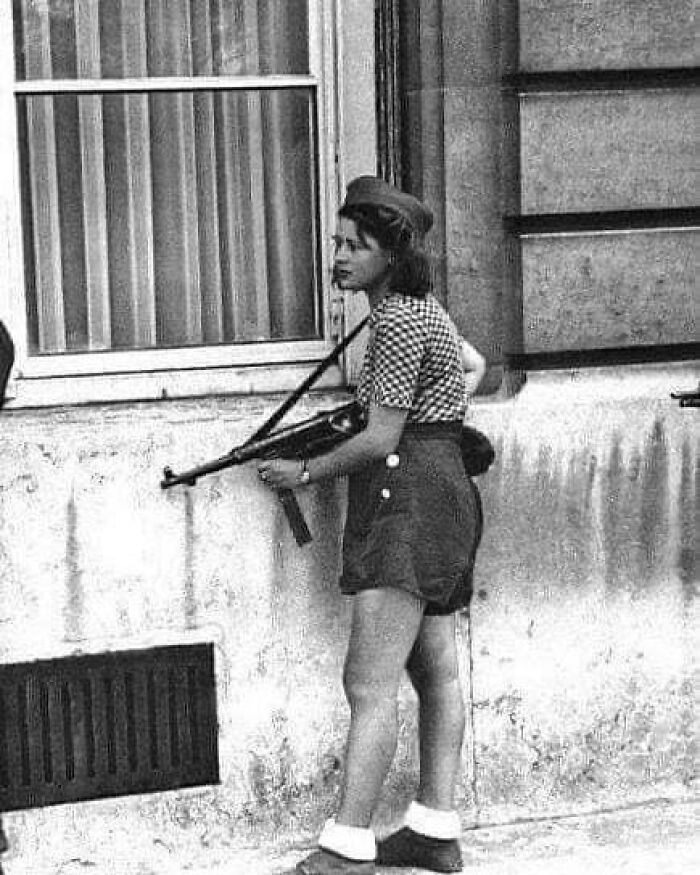
Image source: historic
#6
This is such a powerful photo. It was taken in April, 1945, by Major Clarence Benjamin and shows a train of Jewish prisoners that had been intercepted by Allied Forces. This is the moment they learned that the train would not be heading to a Concentration Camp and they had been liberated.

Image source: historic
#7
In 1968, several months after Dr. Martin Luther King, Jr. had been assassinated, Mister (Fred) Rogers quietly did something at that time that was quite unthinkable – he not only hired a black man to take on a regular role in his children’s television program, “Mister Rogers’ Neighborhood” – and asked him to play a police officer. He would also regularly invite Officer Clemmons to cool his feet in the same pool – together. Years later, in 1993, Officer Clemmons would make his last appearance on Mister Rogers’ Neighborhood. In a touching moment, Mister Rogers once again invited Officer Clemmons, to join him at a pool in the front yard. Two friends, one white, one black, soaked their feet together and discussed the importance of friendship and being kind to one another. As they said their goodbyes, Officer Clemmons emotionally thanked Mister Rogers and said, “I like being a human being right here and now.” A great reminder that wherever there is a human being, there is an opportunity for kindness.
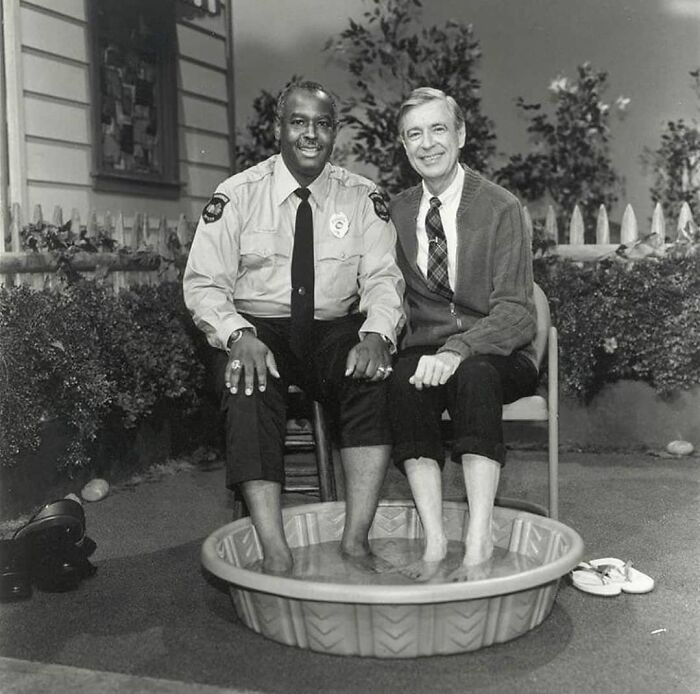
Image source: historic
#8
Famed photographer Sebastião Ribeiro Salgado and his wife Lélia started a project to plant two million trees and now, 20 years later, the seeds have grown into a lush forest in the Minas Gerais region of Brazil.

Image source: historic
#9
Mississippi’s first interracial marriage, August 1970.

Image source: historic
#10
In 1988, Israel Kamakawiwo’ole called the recording studio at 3am and said he had to record a song right away. 15 minutes later, Israel arrived at the studio. The studio owner, Milan Bertosa said, “And in walks the largest human being I had seen in my life.” A security guard gave the 500 pounds man a large steel chair to sit on. Milan said, “Then I put up some microphones, do a quick sound check, roll tape, and the first thing he does is ‘Somewhere Over the Rainbow.’ He played and sang, one take, and it was over.”

Image source: historic
#11
On February 8th, 1943, Nazis hung 17-year-old Lepa Radić for being a Yugoslavian Partisan during World War II. When they asked her the names of her companions, she replied: “You will know them when they come to avenge me.”

Image source: historic
#12
In 1912, Jim Thorpe, an American Indian, had his running shoes stolen on the morning of his Olympic track and field events. He found this mismatched pair of shoes in the garbage and ran in them to win two Olympic gold medals that day.

Image source: historic
#13
The couple on the Woodstock album cover is still together 50 years later.

Image source: historic
#14
“For a small amount of perspective at this moment, imagine you were born in 1900. When you are 14, World War I starts, and ends on your 18th birthday with 22 million people killed. Later in the year, a Spanish Flu epidemic hits the planet and runs until you are 20. Fifty million people die from it in those two years. Yes, 50 million. When you’re 29, the Great Depression begins. Unemployment hits 25%, global GDP drops 27%. That runs until you are 33. The country nearly collapses along with the world economy. When you turn 39, World War II starts. You aren’t even over the hill yet. When you’re 41, the United States is fully pulled into WWII. Between your 39th and 45th birthday, 75 million people perish in the war and the Holocaust kills six million. At 52, the Korean War starts and five million perish. At 64 the Vietnam War begins, and it doesn’t end for many years. Four million people die in that conflict. Approaching your 62nd birthday you have the Cuban Missile Crisis, a tipping point in the Cold War. Life on our planet, as we know it, could well have ended. Great leaders prevented that from happening. As you turn 75, the Vietnam War finally ends. Think of everyone on the planet born in 1900. How do you survive all of that? A kid in 1985 didn’t think their 85 year old grandparent understood how hard school was. Yet those grandparents (and now great grandparents) survived through everything listed above. Perspective is an amazing art. Let’s try and keep things in perspective. Let’s be smart, help each other out, and we will get through all of this. In the history of the world, there has never been a storm that lasted. This too, shall pass.” Photo by Lewis Hine

Image source: historic
#15
A member of the 369th Infantry Regiment (aka “Harlem Hellfighters”) holds a puppy that he saved during World War I (1918)

Image source: historic
#16
Members of the Blackfoot Tribe in Glacier National Park, 1913.

Image source: historic
#17
Anne Frank (1929-1945)

Image source: historic
#18
Robin Williams joins the Denver Broncos Cheerleaders in 1979.

Image source: historic
#19
When Jim Carrey met Stephen Hawking.

Image source: historic
#20
A father comforts his son, David Kirby, on his deathbed in Ohio, 1989. Widely considered the photo that changed the face of AIDS.

Image source: historic
#21
Terry Fox, after losing one of his legs to cancer; embarked on an east to west coast marathon in Canada to raise money for cancer research. He made it 143 days into his run before he lost his battle with cancer at the age of 22 – 1980
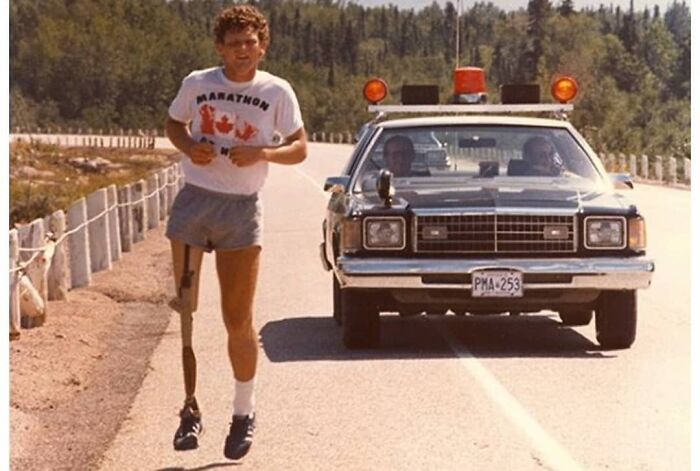
Image source: historic
#22
One of the earliest photos showing a Native American with a wolf – unlike the myths created about wolves by settlers, Indians maintained a close and respectful relationship with wolves.

Image source: historic
#23
A portrait of the Twin Towers in NYC made with the faces of the victims of the 9/11 attacks on the towers.

Image source: historic
#24
A young boy playing the banjo with his best friend, circa early 1900s.

Image source: historic
#25
Barack Obama with his mother on Halloween (1964)

Image source: historic
#26
The man’s name on the left was Horace Greasley. He was a British POW famous for escaping over 200 times to visit his girlfriend, a local Jewish girl. Why did he keep going back? Loyalty. He returned every time with extra food or other contraband to share with his fellow captives. Greasley spent 5 years as a prisoner of war, during which time he served as camp barber and worked in the marble quarries. Following capture, the men were forced to march for ten weeks from France to Poland. The men suffered deplorable conditions and spent a winter, in temperatures as low as -40C, lodged in an old horse stable. Those who survived the march and train transfer were beaten, tortured, and starved. Greasley was once beaten so badly he lay unconscious for 2 days. In 2008, his biography, “Do the Birds Still Sing in Hell?” was published. Two years after its release, he died at age 91. When I see this photo, I always admire the defiance in his face. He refused to be broken. Be that guy. Oh and by the way, the German officer he’s staring down is Heinrich Himmler.
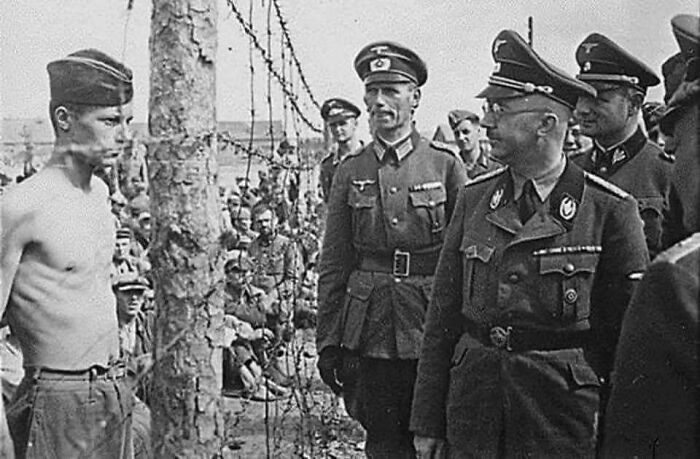
Image source: historic
#27
Babe Ruth posing with African American fans (1925) Babe Ruth, according to baseball historian Bill Jenkinson, was not racist. He chose to play games against “so-called Negro League teams” in 1926, 1927, 1928, and 1929, at a time when others refused to do so. Besides playing, Jenkinson said, Ruth would sit with black players in the dugouts, talk and socialize with them before and after games and mingle in the segregated stands. He scheduled games in locations where interracial competition was not only against local norms but also against the law. Babe Ruth’s daughter, Julia Ruth Stevens, said that she believes her father’s appreciation for black players hurt his chances of becoming a manager for an MLB team in the years before Jackie Robinson broke the color barrier.

Image source: historic
#28
Randall Champion accidentally touched a low-voltage line, electrifying himself and stopping his heart. A fellow linemen J.D. Thompson performed mouth-to-mouth CPR until paramedics arrived. Champion survived. This famous photo is known as “The Kiss of Life.” (1967) (Photo by Rocco Morabito) Taken in 1967 by Rocco Morabito, this photo called “The Kiss of Life” shows a utility worker named J.D. Thompson giving mouth-to-mouth to co-worker Randall G. Champion after he went unconscious following contact with a low voltage line. They had been performing routine maintenance when Champion brushed one of the low voltage lines at the very top of the utility pole. His safety harness prevented a fall, and Thompson, who had been ascending below him, quickly reached him and performed mouth-to-mouth resuscitation. He was unable to perform CPR given the circumstances, but continued breathing into Champion’s lungs until he felt a slight pulse, then unbuckled his harness and descended with him on his shoulder. Thompson and another worker administered CPR on the ground, and Champion was moderately revived by the time paramedics arrived, eventually making a full recovery. What’s even more incredible is Champion not only survived this thanks to Thompson, but he lived an extra 35 years. He died in 2002 at 64 years old. Thompson is still alive today. Rocco Morabito was driving on West 26th Street in July 1967 on another assignment when he saw Champion dangling from the pole. He called an ambulance and grabbed his camera. “I passed these men working and went on to my assignment”, says Morabito. “I took eight pictures at the strike. I thought I’d go back and see if I could rind another picture”. But when Morabito gets back to the linemen, “I heard screaming. I looked up and I saw this man hanging down. Oh my God. I didn’t know what to do. I took a picture right quickly. J.D. Thompson was running toward the pole. I went to my car and called an ambulance. I got back to the pole and J.D. was breathing into Champion. I backed off, way off until I hit a house and I couldn’t go any farther. I took another picture. Then I heard Thompson shouting down: He’s breathing!”.

Image source: historic
#29
On November 27, 1967, a soldier of the 30th regiment of the Baekma Division (백마부대) rescues Vietnamese children at the battle of Dien Can. This soldier’s name is An Sang-Byung (안상병).

Image source: historic
#30
A mom helping her kids beat a hard level in Super Mario Land, 1990s.

Image source: historic
#31
David Bowie chatting with Freddie Mercury backstage at Live Aid, 1985.

Image source: historic
#32
Juliane Koepcke, age 17, was sucked out of an airplane after it was struck by a bolt of lightning. She fell 2 miles to the ground strapped to her seat and survived. However, she had to endure a 10-day walk through the Amazon Jungle before being rescued by a logging team. Out of 93 passengers and crew, Juliane was the only survivor of the LANSA flight 508 crash that took place December 24th, 1971

Image source: historic
#33
A powerful photo showing a priest holding a dying soldier while bullets are fired around them, Venezuela, 1962

Image source: historic
#34
In 1964 a group of high school kids skipped class to go see the Beatles. They didn’t get into the concert but while they were driving Ringo pulled up beside them and snapped their picture. When they told their friends no one believed them. Fast forward 50 years and Ringo publishes a book of his photographs. They were in it. They retook the shot as a look today.

Image source: historic
#35
German Soldiers React To Footage Of Concentration Camps, 1945.

Image source: historic
#36
100 year old picture show how amazing the traditional Rwandan hairstyle was.

Image source: historic
#37
A young man demonstrating against low pay for teachers, ca. 1930. “I left school to earn $21 a week. My teacher’s pay is $17.78 a week.” Photo: Paul Thompson.

Image source: historic
#38
1967: Kathrine Switzer was the first woman to run the Boston marathon. After realizing a woman was running, organizer Jock Semple went after her to stop her. However, Switzers boyfriend and other runners provided a protective shield to protect her for the entire marathon.
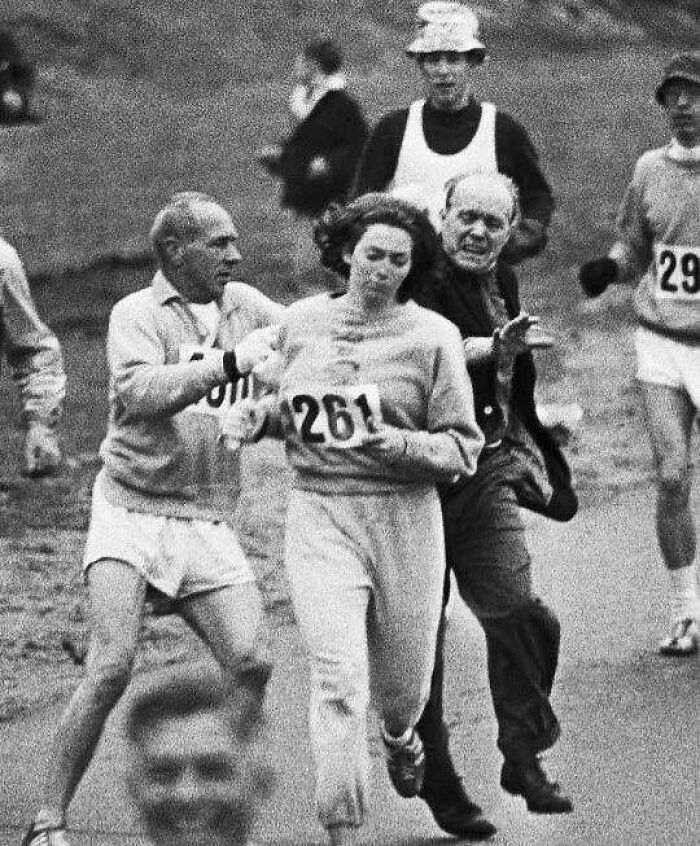
Image source: historic
#39
Robin Williams, 1974

Image source: historic
#40
Franklin D. Roosevelt Jr. in college, fall of 1937

Image source: historic
#41
Princess Diana on a yacht in Portofino, Italy, in August 1997. She died on the 31st of the same month

Image source: historic
#42
This is a colorized photo of 16 year old German soldier, Hans-Georg Henke, crying as he is captured by the US 9th Army in Germany on April 3rd, 1945. He was a member of the Luftwaffe anti-air squad and burst into tears as his world crumbled around him. His father died in 1938, but when his mother died in 1944 leaving the family destitute, Hans-Georg had to find work in order to support the family. At 15 years of age he joined the Luftwaffe

Image source: historic
#43
Yesterday September 10th, 18 years ago 246 people went to sleep in preparation for their morning flights. 2,606 people went to sleep in preparation for work in the morning. 343 firefighters went to sleep in preparation for their morning shift. 60 police officers went to sleep in preparation for morning patrol. 8 paramedics went to sleep in preparation for the morning shift. None of them saw past 10:00am Sept 11, 2001. In one single moment life may never be the same. As you live and enjoy the breaths you take today and tonight before you go to sleep in preparation for your life tomorrow, kiss the ones you love, snuggle a little tighter, and never take one second of your life for granted.

Image source: historic
#44
The creator of the popular cartoon Shrek, William Steig, drew his character from the professional wrestler Maurice Tillet. The real prototype knew 14 languages, played chess brilliantly, and despite his frightening face and great strength at first glance, he was a very modest and friendly man. He was born in 1903 in Russia, in the Urals, into a French family, which in 1917 returned to France in connection with the revolution.

Image source: historic
#45
Queen meets the Queen, 1974

Image source: historic
#46
‘We are dying from overthinking. We are slowly killing ourselves by thinking about everything. Think. Think. Think. You can never trust the human mind anyway. It’s a death trap.’ – Anthony Hopkins.
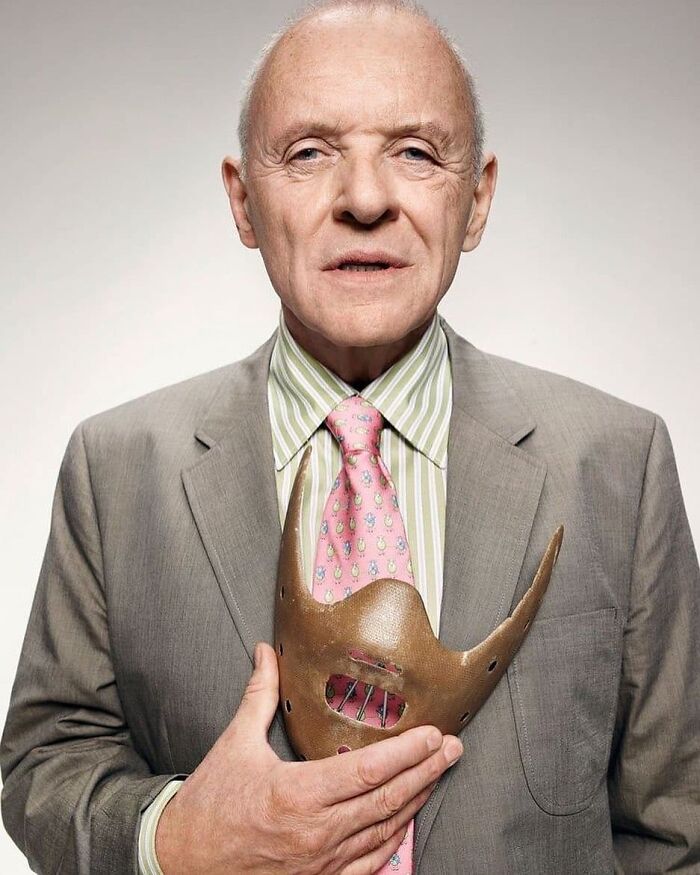
Image source: historic
#47
Rysstad, Norway, 1888 – 2013
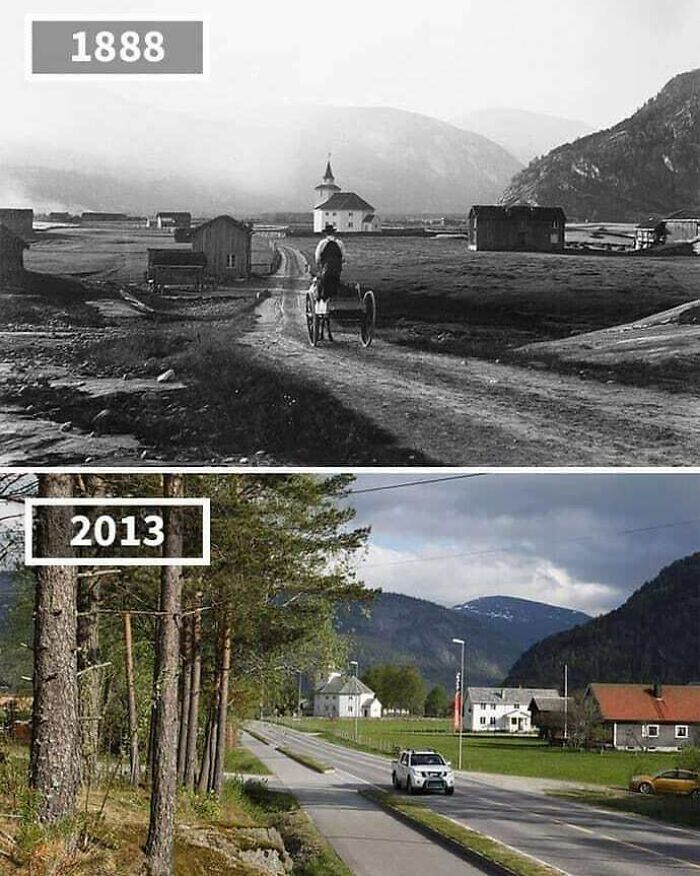
Image source: historic
#48
Julia Stiles, Heath Ledger, Joseph Gordon-Levitt, and Larissa Oleynik take a polaroid selfie on the set of 10 Things I Hate About You, 1999.

Image source: historic
#49
On this day in history, September 11th 2001 President Bush is interrupted at 9:07 a.m. during a school visit in Sarasota, Florida., by Andrew Card, his chief of staff, and informed that a second plane has hit the World Trade Center.

Image source: historic
#50
A mom uses a trash can to contain her baby while she crochets in the park, 1969.

Image source: historic
 Follow Us
Follow Us





